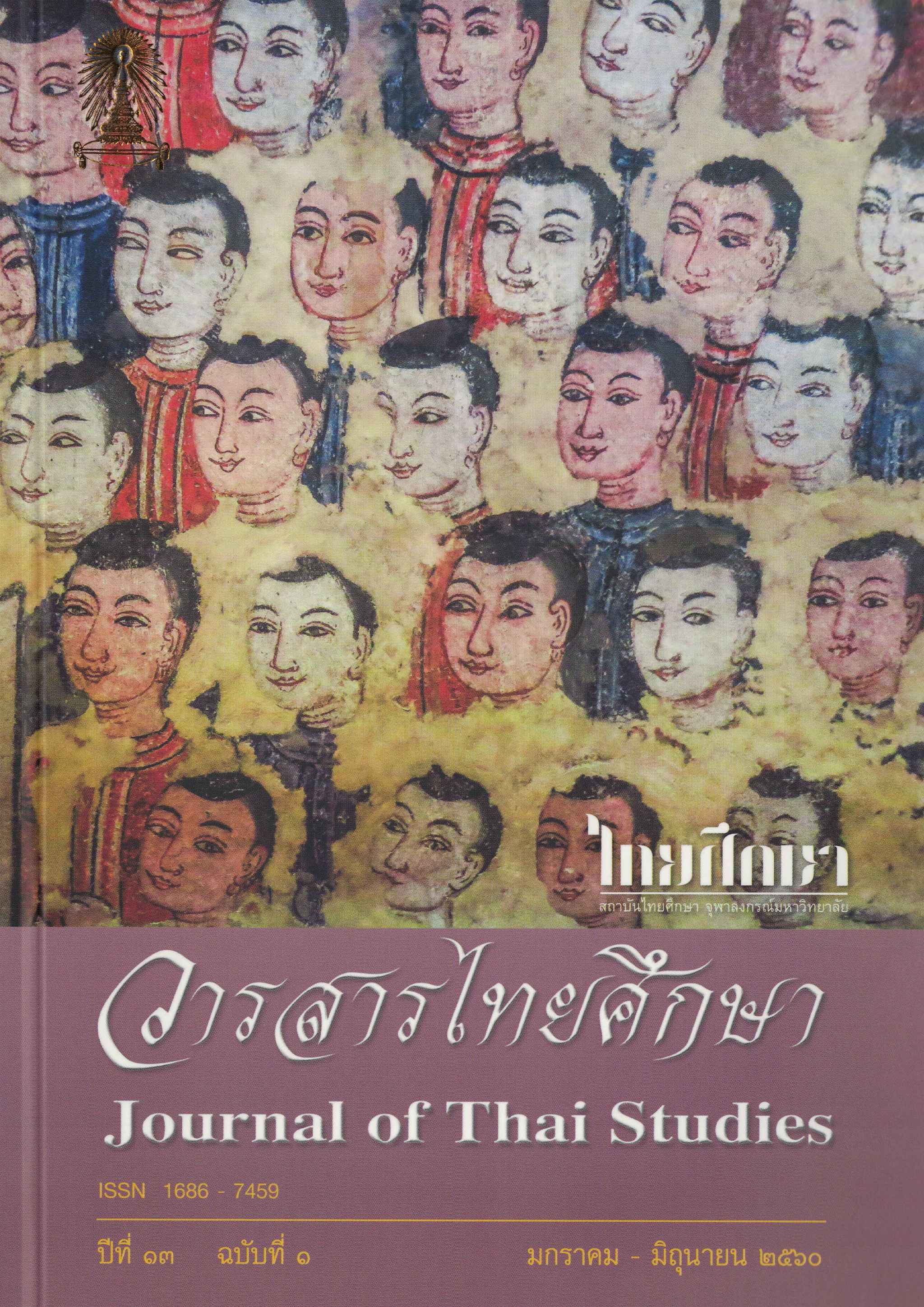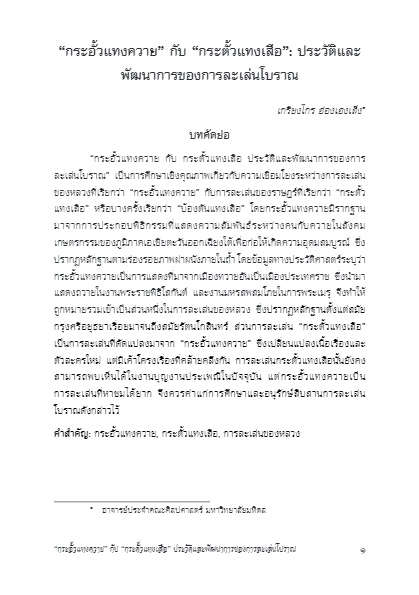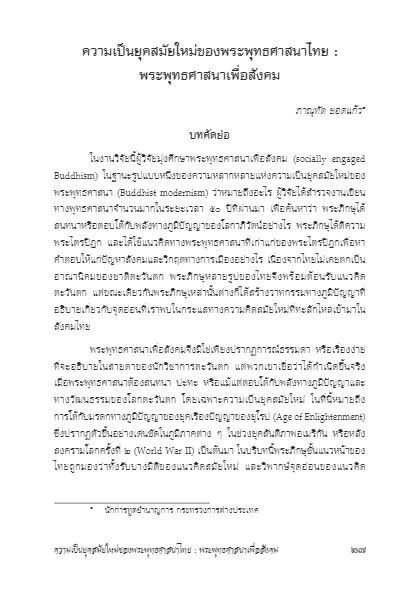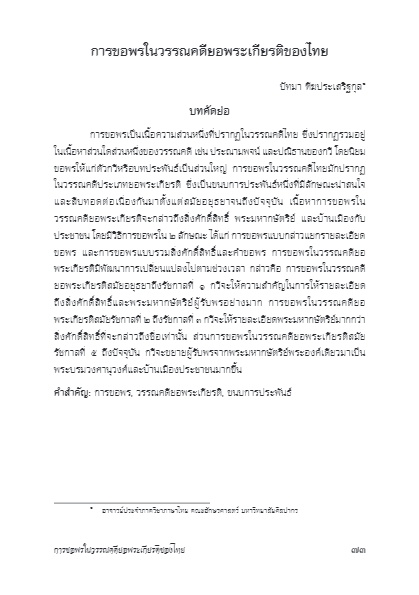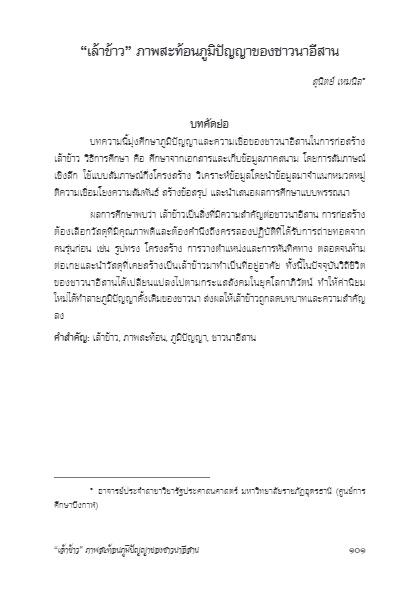วารสารไทยศึกษา - ปีที่ 13 ฉบับที่ 1
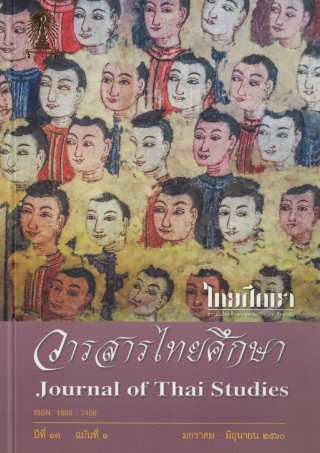
1) “กระอั้วแทงควาย” กับ “กระตั้วแทงเสือ” ประวัติและพัฒนาการของการละเล่นโบราณ / เกรียงไกร ฮ่องเฮงเส็ง
2) ความเป็นยุคสมัยใหม่ของพระพุทธศาสนาไทย : พระพุทธศาสนาเพื่อสังคม / ภาณุทัต ยอดแก้ว
3) พัฒนาการของแบบเรียนในการสอนอ่านเขียนภาษาไทยระดับประถมศึกษาตั้งแต่สมัยรัชกาลที่ 5 จนถึงปัจจุบัน / ภาสพงศ์ ผิวพอใช้
4) การขอพรในวรรณคดียอพระเกียรติของไทย / ปัทมา ฑีฆประเสริฐกุล
5) “เล้าข้าว” ภาพสะท้อนภูมิปัญญาของชาวนาในอีสาน / สุนิตย์ เหมนิล
6) ความสัมพันธ์ระหว่างภาษากับภาพตัวแทนคนอีสานในหนังสือพิมพ์ระดับชาติ : การศึกษาตามแนววาทกรรมวิเคราะห์เชิงวิพากษ์ / สุภัทร แก้วพัตร
"กระอั้วแทงควาย" กับ "กระตั้วแทงเสือ" ประวัติและพัฒนาการของการละเล่นโบราณ
เกรียงไกร ฮ่องเฮงเส็ง
บทคัดย่อ
“กระอั้วแทงควาย กับ กระตั้วแทงเสือ ประวัติและพัฒนาการของการละเล่นโบราณ” เป็นการศึกษาเชิงคุณภาพเกี่ยวกับความเชื่อมโยงระหว่างการละเล่นของหลวงที่เรียกว่า “กระอั้วแทงควาย” กับการละเล่นของราษฎร์ที่เรียกว่า “กระตั้วแทงเสือ” หรือบางครั้งเรียกว่า “บ้องตันแทงเสือ” โดยกระอั้วแทงควายมีรากฐานมาจากการประกอบพิธีกรรมที่แสดงความสัมพันธ์ระหว่างคนกับควายในสังคมเกษตรกรรมของภูมิภาคเอเชียตะวันออกเฉียงใต้เพื่อก่อให้เกิดความอุดมสมบูรณ์ ซึ่งปรากฏหลักฐานตามร่องรอยภาพฝาผนังภายในถ้ำ โดยข้อมูลทางประวัติศาสตร์ระบุว่ากระอั้วแทงควายเป็นการแสดงที่มาจากเมืองทวายอันเป็นเมืองประเทศราช ซึ่งนำมาแสดงถวายในงานพระราชพิธีโสกันต์ และงานมหรสพสมโภชในการพระเมรุ จึงทำให้ถูกหมายรวมเข้าเป็นส่วนหนึ่งในการละเล่นของหลวง ซึ่งปรากฏหลักฐานตั้งแต่สมัยกรุงศรีอยุธยาเรื่อยมาจนถึงสมัยรัตนโกสินทร์ ส่วนการละเล่น “กระตั้วแทงเสือ” เป็นการละเล่นที่ดัดแปลงมาจาก “กระอั้วแทงควาย” ซึ่งเปลี่ยนแปลงเนื้อเรื่องและตัวละครใหม่ แต่มีเค้าโครงเรื่องที่คล้ายคลึงกัน การละเล่นกระตั้วแทงเสือนั้นยังคงสามารถพบเห็นได้ในงานบุญงานประเพณีในปัจจุบัน แต่กระอั้วแทงควายเป็นการละเล่นที่หาชมได้ยาก จึงควรค่าแก่การศึกษาและอนุรักษ์สืบสานการละเล่นโบราณดังกล่าวไว้
คำสำคัญ : กระอั้วแทงควาย, กระตั้วแทงเสือ, การละเล่นของหลวง
(ตีพิมพ์ใน วารสารไทยศึกษา ปีที่ 13 ฉบับที่ 1 (มกราคม – มิถุนายน 2560) หน้า 1-26)
Kraoua Tang Kwai and Kratua Tang Seua: History and Development of Ancient Amusement Play
Kriangkrai Honghengseng
Abstract
Kraoua Tang Kwai and Kratua Tang Seua : History and Development of Ancient Amusement Play was to study the relation between the Kraoua Tang Kwai (Buffalo Stabbing Play), the Royal Amusement Play and Kratua Tang Seua or Bongtan Tang Seua (Tiger Stabbing Play), the Public Amusement Play. The Kraoua Tang Kwai has its roots from ancient ceremony that showed the relation between people and buffalo in agricultural society of Southeast Asian region and was appeared on the cave wall. And historical evidence showed that Thailand was derived Kraoua Tang Kwai from Dawei which was performed in the top knot cutting ceremony and which was performed royal cremation ceremony, and it later became part of the royal amusement play since Ayutthaya until Rattanakosin Era. While, Kratua Tang Seua was applied from Kraoua Tang Kwai by making changes in the cast of the play with similar story line. Nowadays, Kratua Tang Seua still is available in any traditional ceremony. While, Kraoua Tang Kwai is hardly found and thus deserved.
Keywords : Kraoua Tang Kwai or Buffalo Stabbing Play, Kratua Tang Seua or Tiger Stabbing Play, Royal Amusement Play
(Published in Journal of Thai Studies Volume 13 Number 1 (January – June 2017) Page 1-26)
บทความ / Full Text : Download
ความเป็นยุคสมัยใหม่ของพระพุทธศาสนาไทย : พระพุทธศาสนาเพื่อสังคม
ภาณุทัต ยอดแก้ว
บทคัดย่อ
ในงานวิจัยนี้ผู้วิจัยมุ่งศึกษาพระพุทธศาสนาเพื่อสังคม (socially engaged Buddhism) ในฐานะรูปแบบหนึ่งของความหลากหลายแห่งความเป็นยุคสมัยใหม่ของพระพุทธศาสนา (Buddhist modernism) ว่าหมายถึงอะไร ผู้วิจัยได้สำรวจงานเขียนทางพุทธศาสนาจำนวนมากในระยะเวลา 50 ปีที่ผ่านมา เพื่อค้นหาว่า พระภิกษุได้สนทนาหรือตอบโต้กับพลังทางภูมิปัญญาของโลกาภิวัตน์อย่างไร พระภิกษุได้ตีความพระไตรปิฎก และได้ใช้แนวคิดทางพระพุทธศาสนาที่เก่าแก่ของพระไตรปิฎกเพื่อหาคำตอบให้แก่ปัญหาสังคมและวิกฤตทางการเมืองอย่างไร เนื่องจากไทยไม่เคยตกเป็นอาณานิคมของชาติตะวันตก พระภิกษุหลายรูปของไทยจึงพร้อมต้อนรับแนวคิดตะวันตก แต่ขณะเดียวกันพระภิกษุเหล่านั้นต่างก็ได้สร้างวาทกรรมทางภูมิปัญญาที่อธิบายเกี่ยวกับจุดอ่อนที่เราพบในกระแสทางความคิดสมัยใหม่ที่ทะลักไหลเข้ามาในสังคมไทย
พระพุทธศาสนาเพื่อสังคมจึงมิใช่เพียงปรากฏการณ์ธรรมดา หรือเรื่องง่ายที่จะอธิบายในสายตาของนักวิชาการตะวันตก แต่พวกเขาเชื่อว่าได้กำเนิดขึ้นจริง เมื่อพระพุทธศาสนาต้องสนทนา ปะทะ หรือแม้แต่ตอบโต้กับพลังทางภูมิปัญญาและทางวัฒนธรรมของโลกตะวันตก โดยเฉพาะความเป็นยุคสมัยใหม่ ในที่นี้หมายถึงการโต้กับมรดกทางภูมิปัญญาของยุคเรืองปัญญาของยุโรป (Age of Enlightenment) ซึ่งปรากฏตัวขึ้นอย่างเด่นชัดในภูมิภาคต่างๆ ในช่วงยุคสันติภาพอเมริกัน หรือหลังสงครามโลกครั้งที่ 2 (World War II) เป็นต้นมา ในบริบทนี้พระภิกษุชั้นแนวหน้าของไทยถูกมองว่าทั้งรับบางมิติของแนวคิดสมัยใหม่ และวิพากษ์จุดอ่อนของแนวคิดสมัยใหม่เหล่านั้น แต่ขณะเดียวกันพระก็ยังสามารถรักษาแก่นคำสอนทางพระพุทธศาสนาของตนไว้ วาทกรรมของการปะทะกับพลังทางภูมิปัญญาของตะวันตกยังคงดำเนินอยู่และได้มีผลต่อความเข้าใจของพวกเราเกี่ยวกับพระพุทธศาสนาในปัจจุบัน ในงานวิจัยนี้ผู้วิจัยพบว่า การแข่งขันกับแนวคิดสมัยใหม่ของโลกตะวันตก ความล้มเหลวของสถาบันต่างๆในสังคมไทย และการรุกคืบของการเผยแพร่คำสอนของคริสตจักรในประเทศไทยเป็นปัจจัยสำคัญที่ทำให้พระพุทธศาสนาเพื่อสังคมต้องเกิดขึ้นในประเทศไทย
คำสำคัญ : ความเป็นยุคสมัยใหม่ของพระพุทธศาสนา, พระพุทธศาสนาเพื่อสังคม, ยุคสันติภาพอเมริกัน
(ตีพิมพ์ใน วารสารไทยศึกษา ปีที่ 13 ฉบับที่ 1 (มกราคม – มิถุนายน 2560) หน้า 27-54)
Thai Buddhist Modernism : Socially Engaged Buddhism
Panutat Yodkaew
Abstract
In this research, Panutat Yodkaew aims to study what the term “socially engaged Buddhism” as part of the wider spectrum of the so called “Buddhist Modernism” actually means. He explore hundreds of pieces of writing over the past 50 years to see how Buddhist monks reacted to the intellectual force of globalization, how they interpreted the Tripitaka and applied ancient Buddhist thoughts therein to find solutions for social malaise and political crisis confronting Thailand. Due partly to the fact that Thailand has never been colonized by the West, several Thai Buddhist monks are keen to welcome various strands of Western thoughts while at the same time constructing their own versions of intellectual discourses and rhetoric, particularly in relation to what they deem as weak points found in those various modern thoughts and concepts penetrating Thai society.
Socially engaged Buddhism is not a common or easy-to-explain phenomenon for Western academia but this kind of Buddhism was formed when well educated Buddhist monks conversed, confronted and even reacted to the intellectual legacy of the Age of Western Enlightenment that figured predominantly during the rise of Pax Americana following the end of the World War II. In this context, Thailand’s leading Buddhist monks are perceived as negotiating the tension between adopting aspects of western modernity and critiquing them while maintaining what is viewed as the core Buddhist teachings. The discourses of their encounter with the West are still evolving and shaping our understanding of what Buddhism is about. In his research findings, Yodkaew shows that the perceived competition between Buddhism and Christianity and other modern concepts over the past sixty years gave rise to Thailand’s socially engaged Buddhism.
Keywords : Buddhist Modernism, socially engaged Buddhism, Pax Americana
(Published in Journal of Thai Studies Volume 13 Number 1 (January – June 2017) Page 27-54)
บทความ / Full Text : Download
พัฒนาการของแบบเรียนในการสอนอ่านเขียนภาษาไทยระดับประถมศึกษาตั้งแต่สมัยรัชกาลที่ 5 จนถึงปัจจุบัน
ภาสพงศ์ ผิวพอใช้
บทคัดย่อ
งานวิจัยนี้มีวัตถุประสงค์เพื่อวิเคราะห์วิธีสอนอ่านและเขียนจากแบบเรียนหรือหนังสือเรียนภาษาไทยที่ใช้ตั้งแต่สมัยรัชกาลที่ 5 จนถึงปัจจุบัน ผลการวิจัยพบว่า แบบเรียนหรือหนังสือเรียนในแต่ละยุคสมัยมีความมุ่งหมายที่แตกต่างกัน ความแตกต่างดังกล่าวสามารถนำมากำหนดช่วงเวลาของพัฒนาการการสอนอ่าน-เขียนภาษาไทยได้เป็น 2 ช่วง ช่วงแรก จะมุ่งเน้นผลสัมฤทธิ์ให้ผู้เรียนอ่านออกเขียนได้ ต่อมาเมื่อบริบททางสังคมเปลี่ยนแปลงไป และมีการปรับเปลี่ยนหลักสูตร แบบเรียนหรือหนังสือเรียนก็จะมุ่งเน้นผลสัมฤทธิ์ด้านการใช้ภาษาเป็นเครื่องมือสื่อสาร
คำสำคัญ : แบบเรียน, การอ่านและการเรียน, ระดับประถมศึกษา
(ตีพิมพ์ใน วารสารไทยศึกษา ปีที่ 13 ฉบับที่ 1 (มกราคม – มิถุนายน 2560) หน้า 55-71)
The Development of textbooks for teaching reading and writing at the elementary education level from the Reign of King Rama V to the Present
Passapong Pewporchai
Abstract
The research aims to analyze teaching methods from Thai exercise books and textbooks of Thai reading and writing at the elementary education level from the Reign of King Rama V to the Present. The research found that the exercise books and textbooks used in each period had different aims. These differences can be used for specifying the periods of the development of the teaching methods of Thai reading and writing into two periods. The first period aimed at the outcome of enabling learners to read and write Later, with the change in the social context, the curricula were also changed, using exercise books and textbooks that aimed at yielding efficient outcomes in using language as a communicative instrument.
Keywords : textbook, reading and writing, elementary education level
(Published in Journal of Thai Studies Volume 13 Number 1 (January – June 2017) Page 55-71)
บทความ / Full Text : Download
การขอพรในวรรณคดียอพระเกียรติของไทย
ปัทมา ฑีฆประเสริฐกุล
บทคัดย่อ
การขอพรเป็นเนื้อความส่วนหนึ่งที่ปรากฏในวรรณคดีไทย ซึ่งปรากฏรวมอยู่ในเนื้อหาส่วนใดส่วนหนึ่งของวรรณคดี เช่น ประณามพจน์ และปณิธานของกวี โดยนิยมขอพรให้แก่ตัวกวีหรือบทประพันธ์เป็นส่วนใหญ่ การขอพรในวรรณคดีไทยมักปรากฏในวรรณคดีประเภทยอพระเกียรติ ซึ่งเป็นขนบการประพันธ์หนึ่งที่มีลักษณะน่าสนใจและสืบทอดต่อเนื่องกันมาตั้งแต่สมัยอยุธยาจนถึงปัจจุบัน เนื้อหาการขอพรในวรรณคดียอพระเกียรติจะกล่าวถึงสิ่งศักดิ์สิทธิ์ พระมหากษัตริย์ และบ้านเมืองกับประชาชน โดยมีวิธีการขอพรใน 2 ลักษณะ ได้แก่ การขอพรแบบกล่าวแยกรายละเอียดขอพร และการขอพรแบบรวมสิ่งศักดิ์สิทธิ์และคำขอพร การขอพรในวรรณคดียอพระเกียรติมีพัฒนาการเปลี่ยนแปลงไปตามช่วงเวลา กล่าวคือ การขอพรในวรรณคดียอพระเกียรติสมัยอยุธยาถึงรัชกาลที่ 1 กวีจะให้ความสำคัญในการให้รายละเอียดถึงสิ่งศักดิ์สิทธิ์และพระมหากษัตริย์ผู้รับพรอย่างมาก การขอพรในวรรณคดียอพระเกียรติสมัยรัชกาลที่ 2 ถึงรัชกาลที่ 3 กวีจะให้รายละเอียดพระมหากษัตริย์มากกว่าสิ่งศักดิ์สิทธิ์ที่จะกล่าวถึงชื่อเท่านั้น ส่วนการขอพรในวรรณคดียอพระเกียรติสมัยรัชกาลที่ 5 ถึงปัจจุบัน กวีจะขยายผู้รับพรจากพระมหากษัตริย์พระองค์เดียวมาเป็นพระบรมวงศานุวงศ์และบ้านเมืองประชาชนมากขึ้น
คำสำคัญ : การขอพร, วรรณคดียอพระเกียรติ, ขนบการประพันธ์
(ตีพิมพ์ใน วารสารไทยศึกษา ปีที่ 13 ฉบับที่ 1 (มกราคม – มิถุนายน 2560) หน้า 73-100)
Blessing in Thai Panegyric Literature
Pattama Theekapraserlkul
Abstract
A blessing is one of contents in Thai literature which appears in some parts of a story such as invocation and intension of poet. It can be generally seen that the poet or the story are often blessed. A blessing in Thai literature often appears in panegyric literature which is a literary convention that is interesting as well as has been continued from Ayutthaya period to contemporary time. Contents of blessings in panegyric literature are composed of the holy thing, the king and the country with individuals. There are two attributes of blessings: the first is to describe the blessing in details, and the second is to include the holy thing and benediction in the blessing. Blessings in panegyric literature gradually change. That is to say, blessings in panegyric literature during Ayutthaya and Rama I period were focused on the details of the holy thing and the king is blessed. On the one hand, blessings in panegyric literature during Rama II and III period were emphasized on the king more than on the holy thing which was just mentioned only a name. Lastly, blessings in panegyric literature from Rama V to contemporary time have expanded the person who was blessed from the king to the royal family, country and individuals.
Keywords : blessing panegyric, literature literary, convention
(Published in Journal of Thai Studies Volume 13 Number 1 (January – June 2017) Page 73-100)
บทความ / Full Text : Download
"เล้าข้าว" ภาพสะท้อนภูมิปัญญาของชาวนาในอีสาน
สุนิตย์ เหมนิล
บทคัดย่อ
บทความนี้มุ่งศึกษาภูมิปัญญาและความเชื่อของชาวนาอีสานในการก่อสร้างเล้าข้าว วิธีการศึกษา คือ ศึกษาจากเอกสารและเก็บข้อมูลภาคสนาม โดยการสัมภาษณ์เชิงลึก ใช้แบบสัมภาษณ์กึ่งโครงสร้าง วิเคราะห์ข้อมูลโดยนำข้อมูลมาจำแนกหมวดหมู่ ตีความเชื่อมโยงความสัมพันธ์ สร้างข้อสรุป และนำเสนอผลการศึกษาแบบพรรณนา
ผลการศึกษาพบว่า เล้าข้าวเป็นสิ่งที่มีความสำคัญต่อชาวนาอีสาน การก่อสร้างต้องเลือกวัสดุที่มีคุณภาพดีและต้องคำนึงถึงครรลองปฏิบัติที่ได้รับการถ่ายทอดจากคนรุ่นก่อน เช่น รูปทรง โครงสร้าง การวางตำ แหน่งและการหันทิศทาง ตลอดจนห้ามต่อเกยและนำวัสดุที่เคยสร้างเป็นเล้าข้าวมาทำเป็นที่อยู่อาศัย ทั้งนี้ในปัจจุบันวิถีชีวิตของชาวนาอีสานได้เปลี่ยนแปลงไปตามกระแสสังคมในยุคโลกาภิวัตน์ ทำให้ค่านิยมใหม่ได้ทำลายภูมิปัญญาดั้งเดิมของชาวนา ส่งผลให้เล้าข้าวถูกลดบทบาทและความสำคัญลง
คำสำคัญ : เล้าข้าว, ภาพสะท้อน, ภูมิปัญญา, ชาวนาอีสาน
(ตีพิมพ์ใน วารสารไทยศึกษา ปีที่ 13 ฉบับที่ 1 (มกราคม – มิถุนายน 2560) หน้า 101-119)
Rice Barns: A Reflection of Isan Farmers’ Wisdom
Sunit Hemanil
Abstract
This article aimed to examine Isan farmers’ wisdom and belief in constructing rice barns. This was done by investigating related literatures and field surveying through in-depth interview. Semi-structured interview was also selected to collect the data. To analyze the data, all the acquired information was categorized, interpreted to view relation of the farmers’ wisdom and belief, and concluded to reveal toward descriptive results.
The findings found that a rice barn was so important to Isan farmers that they must pursue the following traditional sanctity: 1) only good quality of materials were selected to construct the rice barn, 2) shapes, structures, positioning, and direction of the rice barn must be according to their inherited sanctity, and 3) used materials of rice barn construction must not be utilized in housing construction. Unfortunately, the farmers’ ways of life today was altered according to globalization. New values had affected the old traditional wisdom and belief that a rice barn was overshadowed.
Keywords : rice barns, reflection, wisdom, Isan farmers
(Published in Journal of Thai Studies Volume 13 Number 1 (January – June 2017) Page 101-119)
บทความ / Full Text : Download
ความสัมพันธ์ระหว่างภาษากับภาพตัวแทนคนอีสานในหนังสือพิมพ์ระดับชาติ : การศึกษาตามแนววาทกรรมวิเคราะห์เชิงวิพากษ์
สุภัทร แก้วพัตร
บทคัดย่อ
บทความนี้มีวัตถุประสงค์เพื่อศึกษาภาพตัวแทนคนอีสานที่สื่อผ่านภาษาในหนังสือพิมพ์ระดับชาติระหว่างปี พ.ศ. 2547 ถึง พ.ศ. 2556 ตามแนวการศึกษาวาทกรรมวิเคราะห์เชิงวิพากษ์ โดยศึกษาจากหนังสือพิมพ์ไทยรัฐ และหนังสือพิมพ์เดลินิวส์ เก็บข้อมูลตั้งแต่วันที่ 1 มกราคม 2547 ถึงวันที่ 31 ธันวาคม 2556 จำนวน 1,924 ชิ้นงาน ผลการศึกษาพบว่า หนังสือพิมพ์ระดับชาติมีการใช้กลวิธีทางภาษาในการนำเสนอภาพตัวแทนคนอีสานที่สำคัญทั้งสิ้น 6 กลวิธี ได้แก่ 1) การใช้คำ/กลุ่มคำ 2) การใช้อุปลักษณ์ 3) การใช้มูลบท 4) การใช้โครงสร้างประโยคกรรม 5) การใช้สหบท และ 6) การใช้คำถามเชิงวาทศิลป์ กลวิธีทางภาษาทั้งหมดนี้ได้นำเสนอภาพตัวแทนคนอีสานในหนังสือพิมพ์ระดับชาติ 3 กลุ่ม ได้แก่ 1) ในแง่บุคลิกลักษณะและอุปนิสัย คือ คนอีสานรักศักดิ์ศรีและภูมิใจในท้องถิ่น คนอีสานอดทน และคนอีสานรักพวกพ้องและมีน้ำใจ 2) ในแง่เศรษฐกิจและสังคม คือ คนอีสานมีความรู้น้อยและด้อยโอกาส คนอีสานคือชนชั้นแรงงาน และคนอีสานถูกกระทำจากคนต่างกลุ่ม 3) ในแง่การเมือง คือ คนอีสานคือฐานเสียงสำคัญและมีบทบาททางการเมือง และคนอีสานเป็นเหยื่อทางการเมือง ภาพตัวแทนคนอีสานที่ปรากฏสัมพันธ์กับปริบททางสังคมวัฒนธรรมและสื่อนัยเรื่องความไม่เท่าเทียมกันในสังคม ภาพตัวแทนนี้ถูกสร้างขึ้นผ่านภาษาที่สะท้อนสิ่งที่เกิดขึ้นในสังคมและเป็นสิ่งที่สร้างขึ้นเพื่อให้บรรลุตามเป้าหมายของผู้ต้องการส่งสารนั้น
คำสำคัญ : ภาพตัวแทน, คนอีสาน, วาทกรรมวิเคราะห์เชิงวิพากษ์
(ตีพิมพ์ใน วารสารไทยศึกษา ปีที่ 13 ฉบับที่ 1 (มกราคม – มิถุนายน 2560) หน้า 121-168)
The Relationship between Language and Representations of Isan People in National Newspapers: a Critical Discourse Analysis
Suphat Kaewphat
Abstract
This article aims at examining how Isan people are linguistically represented in national newspapers in Thai between the years 2004 to 2013 by employing the approach of Critical Discourse Analysis. The author focuses on two newspapers, namely Thairath and Dailynews. The data was collected from January 1, 2004 to December 31, 2013. Altogether 1,924 articles and news were collected. The analysis reveals that in the national newspapers several linguistic strategies are employed to represent Isan people. The six major strategies include: 1) lexical choice selection; 2) metaphors; 3) presupposition; 4) the use of passive voice structure; 5) the use of intertextuality; and 6) the use of rhetorical questions. All these linguistic strategies represent of Isan people in three different aspects: 1) Personality and traits: Isan people are proud of themselves and their region. They are patient, group-oriented and generous; 2) Economic and social aspect: Isan people are poorly educated and lack of opportunity. Isan people are labor force. They are victimized by other groups of people; 3) Political aspect: Isan people are a major political stronghold that plays an influential role in Thai politics. However, they often become political victims. The representations of Isan people are prominently related to social context. They are somewhat biased which reflects social inequality.
Keywords : representations, Isan people, Critical Discourse Analysis
(Published in Journal of Thai Studies Volume 13 Number 1 (January – June 2017) Page 121-168)
บทความ / Full Text : Download
